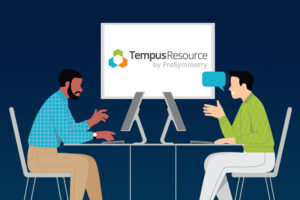Our experience with customers and clients, has taught us about the trials and tribulations of the project and resource management space:
- The problems project and resource managers face
- The importance of resource management
- The limitations of PPM software
- The benefits of dedicated resource management software for you, your workers and your organization
Depending on your role and organization, you may be familiar with the above. If you aren’t, we suggest reading up on what resource management software can offer over standard and even advanced PPM software: from scenario planning to removing your reliance on spreadsheets.
If you’re well-versed on the benefits of resource management, it might be time to talk to higher-ups or stakeholders about the possibility of investing in resource management software. But getting them to listen and take note isn’t always easy. That’s why, in this post, we’re going to list four important elements you’ll want to include in your business case for resource management software.
What is a business case?
A business case is a document that outlines the core benefits a business can expect to see from investing in a product, to justify the investment.
1. Creating Your Premise
Before you can tell your stakeholders the reasons for investing in resource management software, you need to explain your business scenario. This will highlight the problems your organization is currently dealing with, so your stakeholders can better understand your situation.
It’s vital you’re honest here. You need to be hyper-critical of your projects and processes (however difficult that may be!) What are the biggest problems your workers, teams, managers, or overall business are experiencing? How are these problems negatively impacting on things like worker productivity, project deadlines and costs?
For example: We currently don’t have the capacity to keep on top of all our projects. Workers and managers are finding it difficult to distinguish who is working on which project. This is not such a problem for bigger projects, but for smaller product updates, feature enhancements, etc., there isn’t enough information at hand to manage workers effectively. This is hurting our project timeframes, which I believe can be considerably reduced.
2. Current Plan
In the next stage of your business case, you need to explain what your organization is currently trying to do to solve these problems and optimize projects. You don’t want to simply ‘ask’ for a solution—investing in new software isn’t going to provide an automatic fix to projects. So, you need to show what you’re currently attempting to do to solve the problem. This will also explain to higher-ups that you are (or have) tried to solve the problem but need additional help.
Real change and benefits come from how your people work, especially when it comes to project management. So, it’s good to position this section around the practices your workers are currently undergoing (and have problems with). Are you dealing with dispersed workers who have trouble communicating? Are workers not filling in timesheets correctly, or with enough accuracy?
For example: With resources spread across multiple locations around the world, transparency, collaboration, and visibility over resources is suffering. Resources are tracked via Excel spreadsheets – separated by geographic location – and managers can view and collaborate on these together. But there is no system to present an overview of what everyone is working on and how much time is being spent on each project. A holistic view is needed to foster communications between workers, projects, and wider business functions.
3. A New Way Forward
Now you’ve detailed the problems your projects and people are experiencing, you can move on to a proposed solution. In this section, you can highlight resource management—briefly describing what it is and how it works. This can initially afford to be more general, looking at areas like improved control and visibility over project resources.
You then need to go into how resource management software can make an impact on your current PPM setup. This is where you can be more specific, as stakeholders need to visualize how, exactly, resource management will improve your projects, processes, and people.
For example: Standardized resource management practices could significantly improve visibility and control over project workers—better realizing who is available and best-suited to tasks at hand. With resource management software, project managers and resource planners can forecast resource allocation ahead of time to better deal with project changes and make more informed decisions.
4. A Tool Like Tempus Resource
As your final step, you can put forward your proposed solution—in the form of resource management software. You can list a specific tool and its features, showing practical examples of how it can help the overall business. It is also a good idea to compare features and functionality against your current software set-up, to re-iterate the benefits of investing in dedicated resource management.
For example: Tempus Resource would provide us with more capability than the PPM system we currently have in place, helping us solve the our problems. Scenario planning and resource forecasting features in Tempus Resource would give project managers more control over their projects, which will ultimately lead to reduced costs, improved project delivery and increased revenue.
Resource Management Software You Can Trust
This is a general structure for How to write a business case. To best justify investing in resource management software, you might want to conduct additional research. Market analysis, risk analysis, resource requirements and timescales will give your business case more depth and provide a more compelling argument for investing in resource management software. But these four steps should get you started on structuring your business case.
If you need additional advice on the benefits of resource management, get in touch with us.



